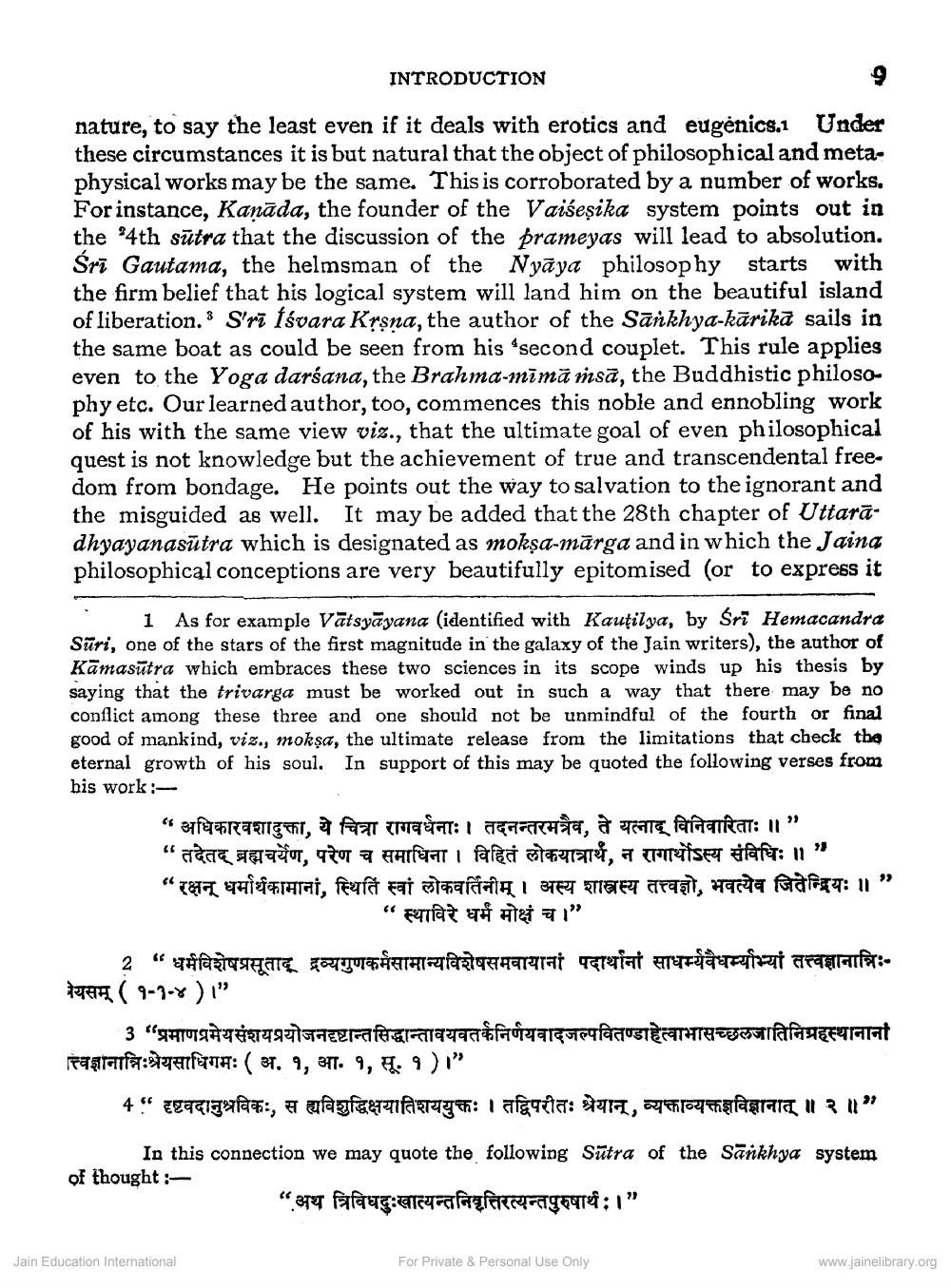________________
INTRODUCTION
nature, to say the least even if it deals with erotics and eugenics.1 Under these circumstances it is but natural that the object of philosophical and metaphysical works may be the same. This is corroborated by a number of works. For instance, Kanāda, the founder of the Vaišesika system points out in the 34th sūtra that the discussion of the prameyas will lead to absolution.
rī Gautama, the helmsman of the Nyāya philosophy starts with the firm belief that his logical system will land him on the beautiful island of liberation. 3 Sri fśvara Krsna, the author of the Sankhya-kārikā sails in the same boat as could be seen from his second couplet. This rule applies even to the Yoga darśana, the Brahma-mīmāṁsā, the Buddhistic philosaphy etc. Our learned author, too, commences this noble and ennobling work of his with the same view viz., that the ultimate goal of even philosophical quest is not knowledge but the achievement of true and transcendental freedom from bondage. He points out the way to salvation to the ignorant and the misguided as well. It may be added that the 28th chapter of Uttarādhyayanasūtra which is designated as mokşa-mārga and in which the Jaina philosophical conceptions are very beautifully epitomised (or to express it
1 As for example Vätsyāyana (identified with Kautilya, by Śrī Hemacandra Sūri, one of the stars of the first magnitude in the galaxy of the Jain writers), the author of Kāmasūtra which embraces these two sciences in its scope winds up his thesis by saying that the trivarga must be worked out in such a way that there may be no conflict among these three and one should not be unmindful of the fourth or final good of mankind, viz., mokşa, the ultimate release from the limitations that check the eternal growth of his soul. In support of this may be quoted the following verses from his work:
" अधिकारवशादुक्ता, ये चित्रा रागवर्धनाः। तदनन्तरमत्रैव, ते यत्नाद् विनिवारिताः ॥" " तदेतद् ब्रह्मचर्येण, परेण च समाधिना । विहितं लोकयात्राथ, न रागार्थोऽस्य संविधिः ॥" "रक्षन धर्मार्थकामानां, स्थितिं स्वां लोकवर्तिनीम् । अस्य शास्त्रस्य तत्त्वज्ञो, भवत्येव जितेन्द्रियः॥"
“ Fiat TATET "
2 "धर्मविशेषप्रसूताद् द्रव्यगुणकर्मसामान्यविशेषसमवायानां पदार्थानां साधर्म्यवैधाभ्यां तत्त्वज्ञानान्निः1447 ( 9-9-8)."
3 "प्रमाणप्रमेयसंशयप्रयोजनदृष्टान्तसिद्धान्तावयवतर्कनिर्णयवादजल्पवितण्डाहेत्वाभासच्छलजातिनिग्रहस्थानानां Fararata:24mfa: ( 87. 9, T. 9, H. 9)."
4" Ezaaitafari:, a afagianfrag: 1 afecta: 1417, 2274 fagrara u ll "
In this connection we may quote the following Sūtra of the Sankhya system of thought :
"Te Gafrag:arcara Falleredragarei:"
Jain Education International
For Private & Personal Use Only
www.jainelibrary.org




